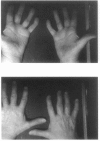Abstract
Multiple epiphyseal dysplasia (MED) comprises a group of hereditary chondrodysplasias in which there are major anatomic abnormalities of the long tubular bones. The Fairbank and Ribbing types are the most frequently cited types of MED. They are primarily defined radiographically and are autosomal dominant conditions. Recently, MED in one family was shown to map to the pericentromeric region of chromosome 19 and is probably allelic to pseudoachondroplasia. We have tested linkage with six short tandem repeat markers from chromosome 19 to autosomal dominant MED in one four-generation family and to MED in a unique family with three of seven siblings affected and with unaffected parents. Autosomal dominant MED in family 1 was linked with a maximum LOD score, at D19S212, of 3.22 at a recombination fraction (theta) of .00. Linkage to chromosome 19 was excluded with MED in the other family, under both autosomal recessive and autosomal dominant, with either reduced-penetrance or germ line-mosaicism models. Linkage to candidate genes COL9A1, COL9A2, and COL11A2 was tested and excluded for both genetic models in this family. COL11A1 was excluded under a recessive model. We have confirmed linkage of autosomal dominant Fairbank MED to chromosome 19 and have demonstrated that MED is genetically heterogeneous.
Full text
PDF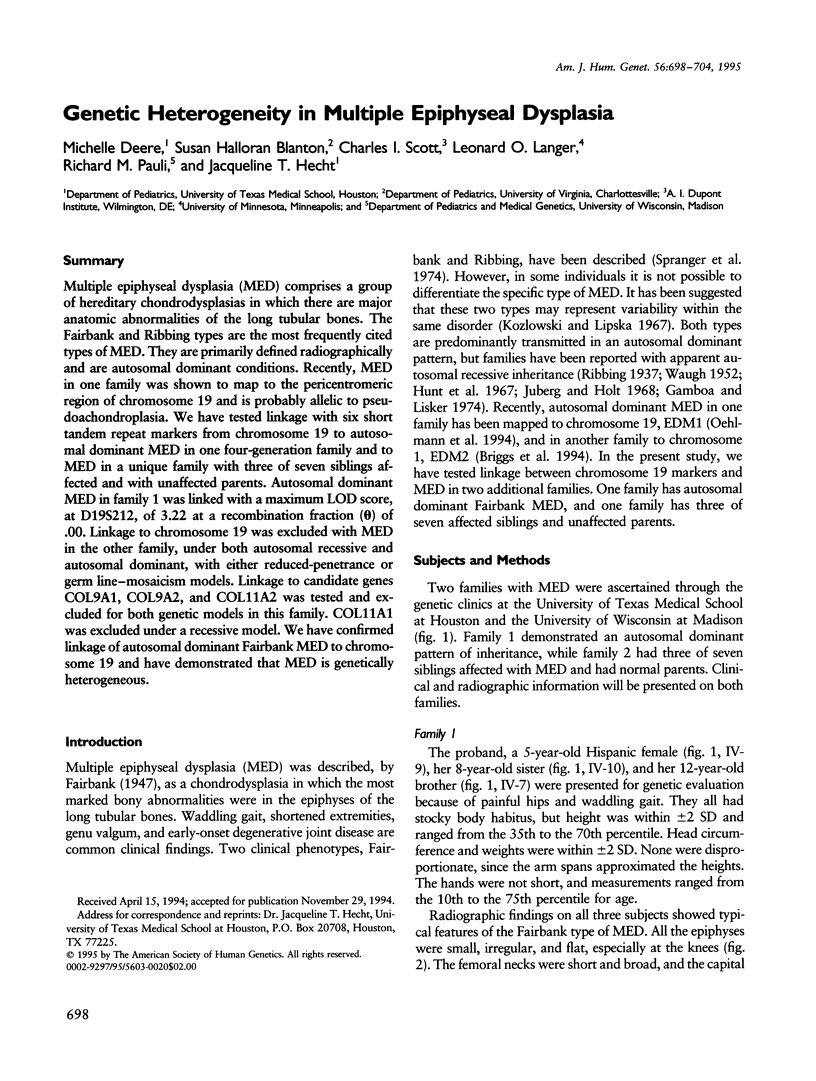
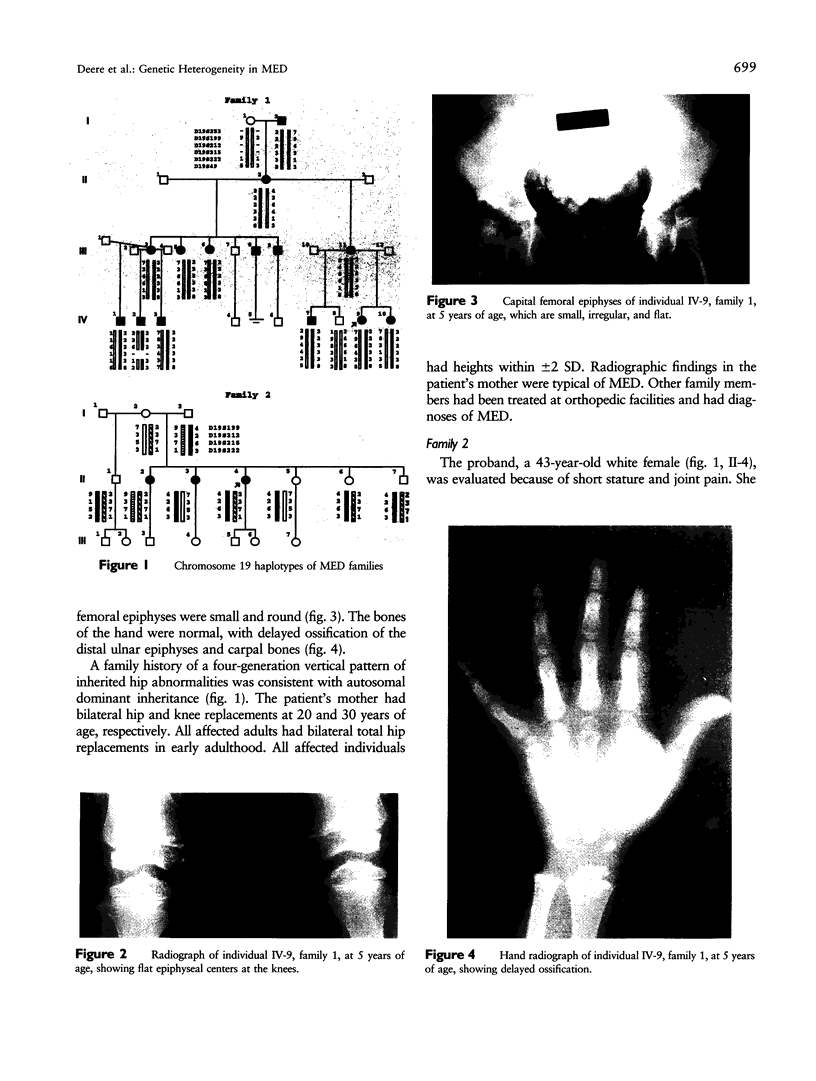
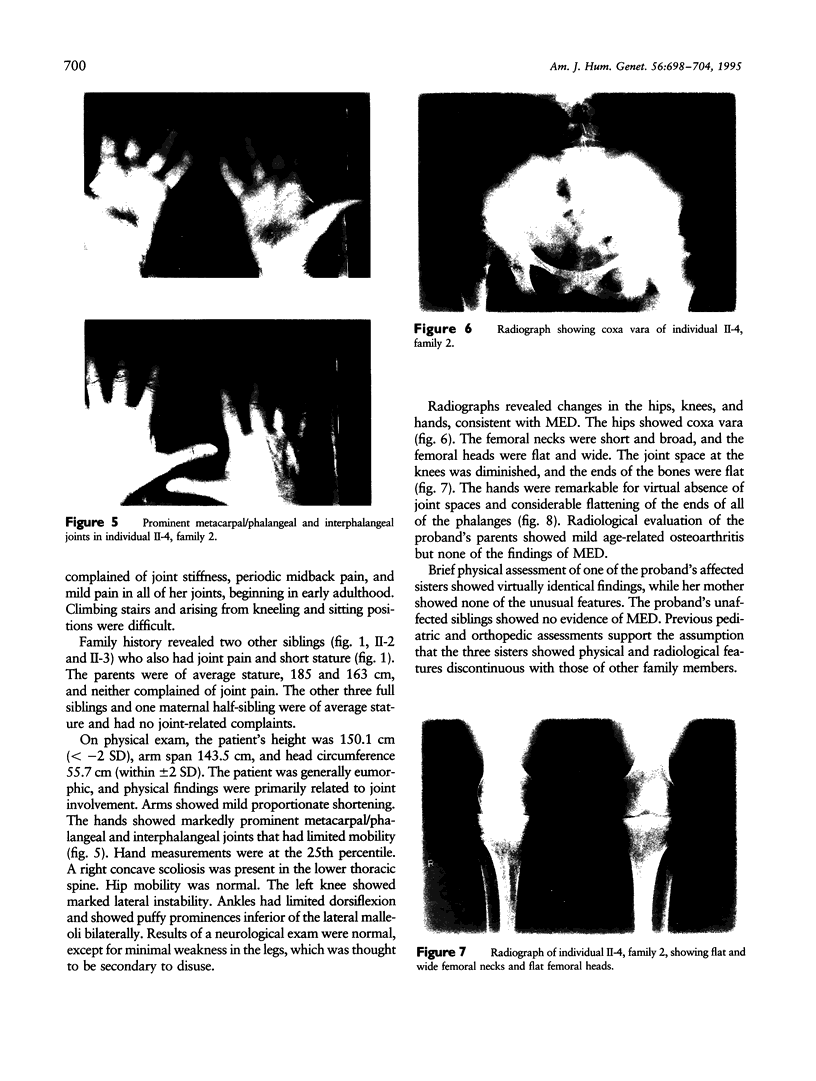

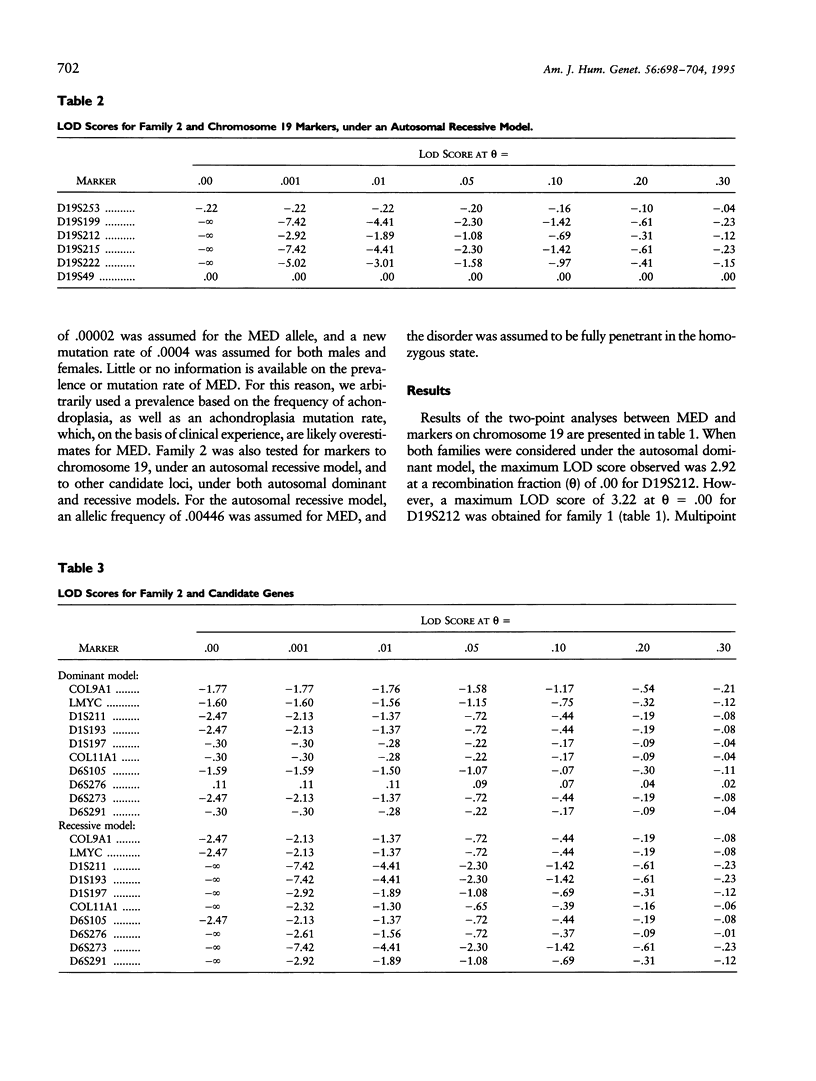
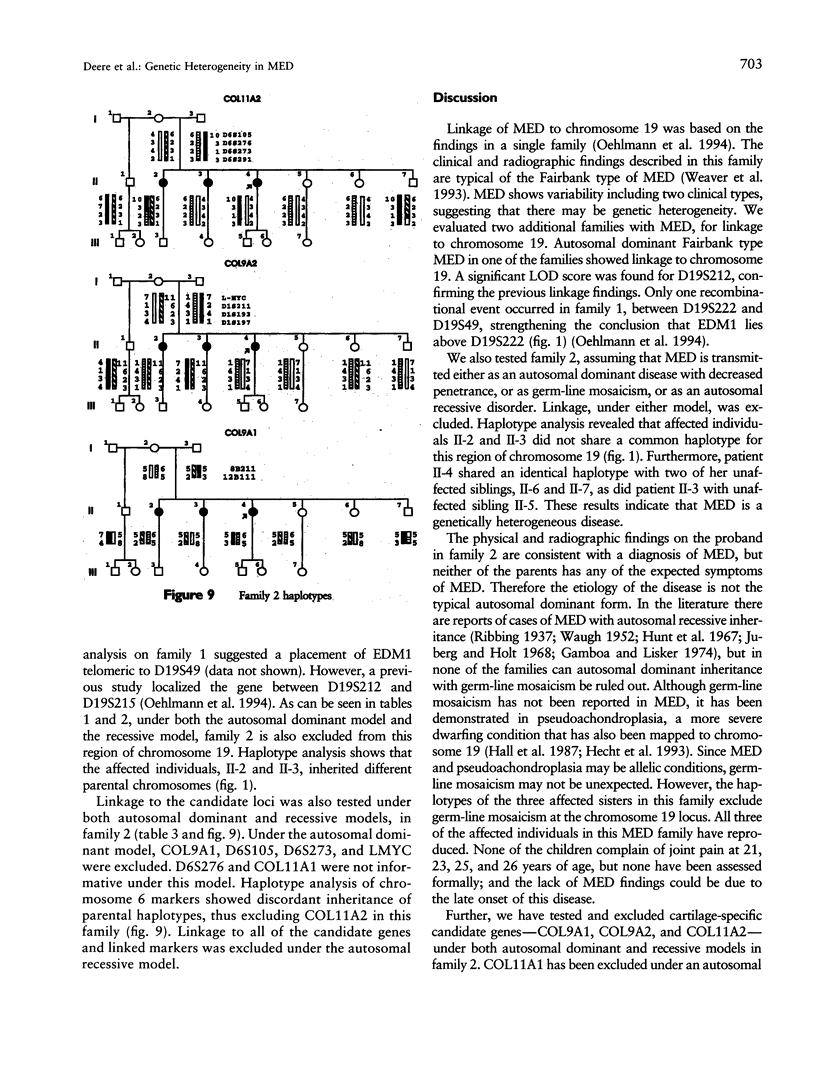
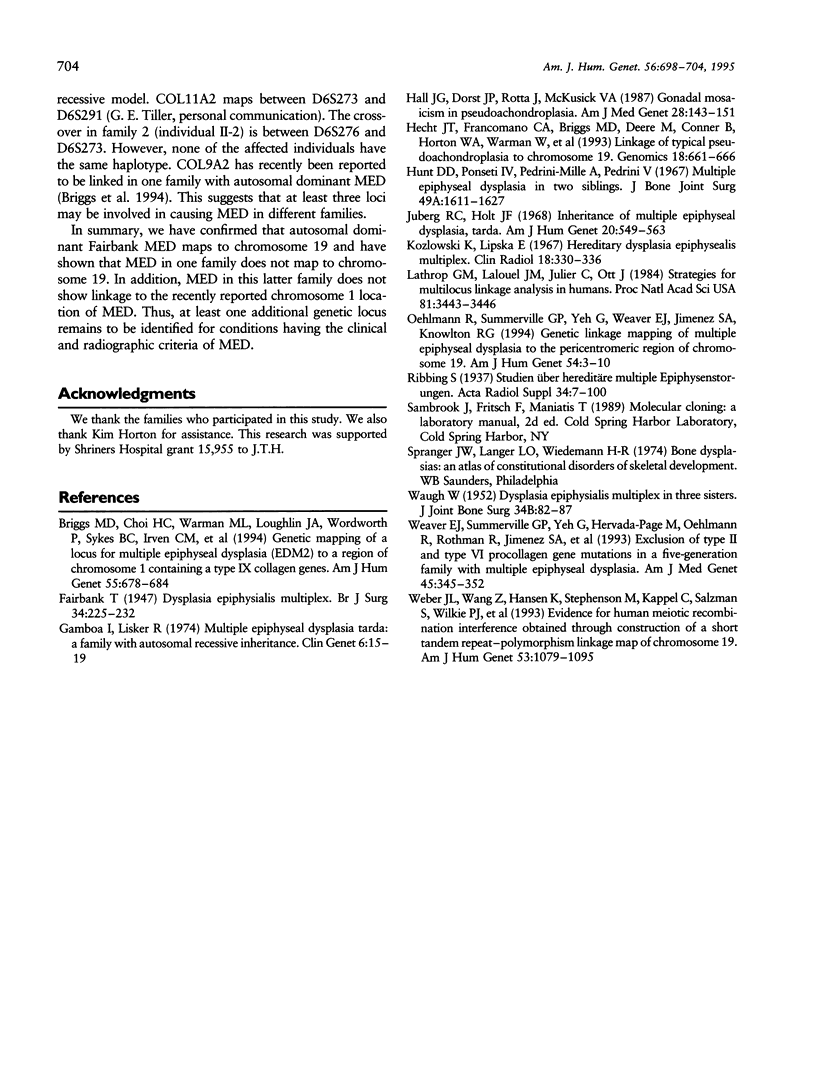
Images in this article
Selected References
These references are in PubMed. This may not be the complete list of references from this article.
- Briggs M. D., Choi H., Warman M. L., Loughlin J. A., Wordsworth P., Sykes B. C., Irven C. M., Smith M., Wynne-Davies R., Lipson M. H. Genetic mapping of a locus for multiple epiphyseal dysplasia (EDM2) to a region of chromosome 1 containing a type IX collagen gene. Am J Hum Genet. 1994 Oct;55(4):678–684. [PMC free article] [PubMed] [Google Scholar]
- Gamboa I., Lisker R. Multiple epiphyseal dysplasia tarda. A family with autosomal recessive inheritance. Clin Genet. 1974;6(1):15–19. [PubMed] [Google Scholar]
- Hall J. G., Dorst J. P., Rotta J., McKusick V. A. Gonadal mosaicism in pseudoachondroplasia. Am J Med Genet. 1987 Sep;28(1):143–151. doi: 10.1002/ajmg.1320280121. [DOI] [PubMed] [Google Scholar]
- Hecht J. T., Francomano C. A., Briggs M. D., Deere M., Conner B., Horton W. A., Warman M., Cohn D. H., Blanton S. H. Linkage of typical pseudoachondroplasia to chromosome 19. Genomics. 1993 Dec;18(3):661–666. doi: 10.1016/s0888-7543(05)80370-2. [DOI] [PubMed] [Google Scholar]
- Hunt D. D., Ponseti I. V., Pedrini-Mille A., Pedrini V. Multiple epiphyseal dysplasia in two siblings. Histological and biochemical analyses of epiphyseal plate cartilage in one. J Bone Joint Surg Am. 1967 Dec;49(8):1611–1627. [PubMed] [Google Scholar]
- Juberg R. C., Holt J. F. Inheritance of multiple epiphyseal dysplasia, tarda. Am J Hum Genet. 1968 Nov;20(6):549–563. [PMC free article] [PubMed] [Google Scholar]
- Kozlowski K., Lipska E. Hereditary dysplasia epiphysealis multiplex. Clin Radiol. 1967 Jul;18(3):330–336. doi: 10.1016/s0009-9260(67)80083-7. [DOI] [PubMed] [Google Scholar]
- Lathrop G. M., Lalouel J. M., Julier C., Ott J. Strategies for multilocus linkage analysis in humans. Proc Natl Acad Sci U S A. 1984 Jun;81(11):3443–3446. doi: 10.1073/pnas.81.11.3443. [DOI] [PMC free article] [PubMed] [Google Scholar]
- Oehlmann R., Summerville G. P., Yeh G., Weaver E. J., Jimenez S. A., Knowlton R. G. Genetic linkage mapping of multiple epiphyseal dysplasia to the pericentromeric region of chromosome 19. Am J Hum Genet. 1994 Jan;54(1):3–10. [PMC free article] [PubMed] [Google Scholar]
- Weaver E. J., Summerville G. P., Yeh G., Hervada-Page M., Oehlmann R., Rothman R., Jimenez S. A., Knowlton R. G. Exclusion of type II and type VI procollagen gene mutations in a five-generation family with multiple epiphyseal dysplasia. Am J Med Genet. 1993 Feb 1;45(3):345–352. doi: 10.1002/ajmg.1320450312. [DOI] [PubMed] [Google Scholar]
- Weber J. L., Wang Z., Hansen K., Stephenson M., Kappel C., Salzman S., Wilkie P. J., Keats B., Dracopoli N. C., Brandriff B. F. Evidence for human meiotic recombination interference obtained through construction of a short tandem repeat-polymorphism linkage map of chromosome 19. Am J Hum Genet. 1993 Nov;53(5):1079–1095. [PMC free article] [PubMed] [Google Scholar]






